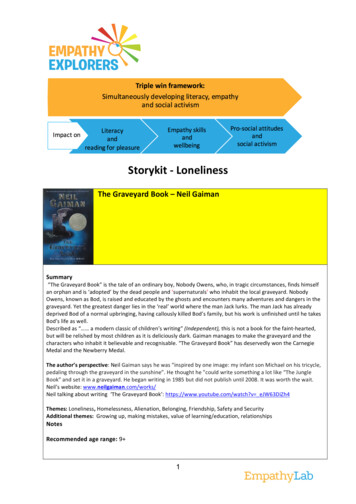
Transcription
Storykit - LonelinessThe Graveyard Book – Neil GaimanSummary“The Graveyard Book” is the tale of an ordinary boy, Nobody Owens, who, in tragic circumstances, finds himselfan orphan and is ‘adopted’ by the dead people and ‘supernaturals’ who inhabit the local graveyard. NobodyOwens, known as Bod, is raised and educated by the ghosts and encounters many adventures and dangers in thegraveyard. Yet the greatest danger lies in the ‘real’ world where the man Jack lurks. The man Jack has alreadydeprived Bod of a normal upbringing, having callously killed Bod’s family, but his work is unfinished until he takesBod’s life as well.Described as “ a modern classic of children’s writing” (Independent), this is not a book for the faint-hearted,but will be relished by most children as it is deliciously dark. Gaiman manages to make the graveyard and thecharacters who inhabit it believable and recognisable. “The Graveyard Book” has deservedly won the CarnegieMedal and the Newberry Medal.The author’s perspective: Neil Gaiman says he was “inspired by one image: my infant son Michael on his tricycle,pedaling through the graveyard in the sunshine”. He thought he "could write something a lot like “The JungleBook” and set it in a graveyard. He began writing in 1985 but did not publish until 2008. It was worth the wait.Neil’s website: www.neilgaiman.com/works/Neil talking about writing ‘The Graveyard Book’: https://www.youtube.com/watch?v eJW63DiZh4Themes: Loneliness, Homelessness, Alienation, Belonging, Friendship, Safety and SecurityAdditional themes: Growing up, making mistakes, value of learning/education, relationshipsNotesRecommended age range: 9 1
OrientationLonely refugee children: rds-Michelle-Dockery.htmlKids’ Health – Feeling etailsKids.aspx?p 335&np 287&id 1800What does it feel like to be old and alone? - https://www.youtube.com/watch?v V5EsxU84ay4Songs“Eleanor Rigby” – The Beatles“Streets of London” – Ralph McTellActivitiesEmpathy skillspractisedLearningapproachesAll CharactersAppearanceLarge (whole wall) picture of the graveyard – each timea character appears create a new gravestone with theirname on it and brief details of them. Add a picture ofthem next to the gravestone.Strong imaginationSpringboard forclass/ groupdiscussionsPersonalityCreate a large ledger/census book. Pages tea-soaked tomake it look ancient. In the ledger enter details of eachcharacter as they join the story r columns could be: Accommodation, Status e.g.alive/ dead, undead. Group affiliation e.g. Ghoul, Celt,Hound of God, Night Haunt, Witch, Unconsecrated,Jacks of All Trades, Honour Guard, Police etc.2Capacity for reflectionCreative writing
The Detective’s Couch (have one in classroom, ifpossible)Hot seating by another, gentler name – ask questionsof different characters, discuss/modify answers. Whenwere you born? Who are your friends? Where do youlive? What are your targets? What would you changeabout your life?Strong imaginationEmpatheticcommunicationEmotion recognitionDramaEmpathic listeningStrong imaginationCreative writingMaking FriendsEmpathic listeningHow does Bod change, from loneliness to feeling securein the graveyard and then independent and ready to gointo the world?The ability to feel,understand andrespect other people’sfeelings andperspectivesDiscussion andteam workDramaCreative writingand artAct out the words spoken by different characters e.g.,Sleer – are they friendly, scary, threatening, Discusshow they feel? Why are l/callous etc?The Main Characters: Nobody Owens, Mr and MrsOwens, Silas, the man Jack, Scarlett, Liza, MissLupescu (groups might wish to take one each, but allneed to focus upon Bod at some point).Nobody Owens (Bod)Bod experiences a whole range of emotions as hegrows and develop; these are central to the story andsome will be familiar to the children e.g. being bullied,upset at parents who won’t allow you to do what youwant, “It’s not fair!”Write Bod’s early experience of leaving his home in thefirst person – climbing out of cot, hearing strangesounds, sense of adventure, fear and feeling lost, dark,quiet streets, graveyard, first encounters with Mr andMrs Owens, Silas, Scarlett.What has Bod lost? Parents, sister, home and all itscomforts, safety, security etc. What does that feel likeWhat do the Graveyard characters provide for Bod?Balloon Debate – Create a balloon with a basketunderneath, get the children to draw the charactersand put them in basket: Scarlett, Silas, Mr Owens, MrsOwens, Miss Lupescu, Liza. Each child takes a characterand argues why they are important to Bod and whythey should remain in the descending balloon. Childrenvote on who offers the least each time and that3
character leaves the balloon. End of book.E.g., Silas food, clothes, advice, guidance, reliability,safetyScarlett friendship, teaching about the outside world,fun, camaraderie, romance (?)Children explore what makes a good friendCreate an “Are you a good friend?” questionnaire a lamagazines e.g.Your friend is talking about his/her holiday; it is gettingboring. Do you:a) Tell her to be quiet – you’ve heard enough?b) Walk off?c) Try to change the conversation?d) Ask questions and appear interested?Partners try to come up with one question andquestions put together to form quiz. Aim to establishwhy friends are so important and attributes of a truefriend.Dead or Alive – Pros and ConsWhat are the advantages/disadvantages of living in the‘real’ world and the graveyard? Large flipchart orsimilar with columns “Pros” “Cons”. Alive/Real World“Pros” might include: meet lots of people, TV,computers, phones, family, friendships, aspirations,travel, new experiences, food etc. Cons might be:hardship, losing loved ones, exams, ageing, pain, illness,can’t disappear/walk through walls. Dead/Graveyard“Pros” might be: never ageing, no diseases, safety andsecurity of Graveyard (debatable), invisibility,Dreamwalking, Visitations, Hauntings. Cons might be:stuck in time, no aspirations/opportunities, an observerof real life unable to participate, dangers of othergroups e.g. GhoulsValuing/understandingothers’ perspectivesCelebrating differenceBod is different to other children. Discuss how we areall different – illustrate with simple exercises: rollingtongue, rolling Rs, speed of reactions catching a rulerbetween forefinger and thumb when dropped bysomeone else – record scores, shyness, academicability etc. List all ways in which we can be different.Imagine a world in which everyone is the same –imagine how boring it would be. Sometimes differencecan lead to isolation, ostracism and loneliness –Joseph/John Merrick (Elephant Man) is a classic andDeep discussionStrong imaginationCapacity for reflection4Writing anddiscussionthe capacity forreflectionImmersive creativeactivities
extreme example:https://en.wikipedia.org/wiki/Joseph MerrickBut also today: Loneliness in the playground – have youevery felt alone/left out at school? What can you do ifyou see someone looking lonely or you are lonely?Create class/school guidelines (you may have thesealready e.g. Friendship bench, playground mentors,buddy system etc.)At school Bod is seemingly invisible because he is quiet;“No-one noticed the boy” “forgettable and easilyforgotten”. Why not befriend someone you don’tusually talk to? Talking partners – find out someinteresting things about your talking partner and tellthe class about them e.g. Josie has been in thenewspaper, goes to gymnastics outside school etc.Growing up/AspirationsBecause Bod is alive, he eventually heads off into thereal world, with “dangers in it and mysteries, newfriends to make, old friends to rediscover, mistakes tobe made and many paths to be walked .” Bod walksinto it with “ his eyes and heart wide open.”Children write about the things that excite them aboutthe future and those that might be causing them someanxiety i.e. meeting new friends, being lonely in the“big school”. This is a good opportunity to discussanxieties of Y6 going to secondary school and howthere will be people to help/turn to along the way.Loneliness in the newsLook at images of people in the news who are alonee.g. elderly person living alone with no family, tsunamivictim, refugee, earthquake victim i.e. people who havelost everything dear to them: put yourself in the shoesof one of them – describe how you feel.Social ActionWho do you know who might be lonely? At school,home, family, neighbours, local community, thecountry the world? How can you help?Visit a neighbour (with parent), arrange agrandparent’s, elderly friends’ tea party/ concert. Visitlocal senior citizens’ home?Take turns to be a playground buddy, helping/playingwith children who appear lonely on the playground.Raise money for homeless refuge in the area. Becomepen pals/cyber friend with child overseas.5Strong imaginationValuing/understandingothersActivities that helpchildren seethrough the eyes ofthe charactersCapacity for reflectionThe ability to feel,understand andrespect other people’sfeelings andperspectivesCreative writingdiscussionEmpathic listeningOpportunities forclass and groupdiscussionsDeep discussion
Booklist (additional stories on the theme)Stor TitleAuthorOliver TwistDickensNim’s IslandWendy OrrMatildaRoald DahlBillionaire BoyDavid WalliamsAre you thereGod, it’s meMargaretJudy BlumeThe Secret GardenFrances HodgsonBurnettBecause of WinnDixieKate DiCamilloThe Selfish GiantOscar WildeEverything for adogAnn MartinA Horse calledHeroSam AngusThe ScarCharlotte MoundlicStory of BearHilary McKayCaveLauren ChildAbyssPaul BryersAlice Knows BestKaren WallaceBoobela andWormDancing BearJoe FriedmanForever RoseHilary McKayPublisherMichael Morpurgo6Suggested agerangeIn print
The Kazillion WishNick PlaceLonely PirateJillian PowellRapunzelThe LonelyPrincessOscar’s LonelyChristmasSaviour PirottaThe Lonely BeastChris JudgeRobinson CrusoeCartoon version:https://www.youtube.com/watch?v SRscJGE13OADaniel DefoeThe Jungle BookRudyard KiplingHolly WebbTrailer:https://www.youtube.com/watch?v ytpwzj6Ldo8New Disney movieout in 2016.A note about StorykitsEmpathy Storykits aim to help children understand other people through a story and characters.The text is used as a springboard for discussion, activities and social action.Empathy skills supported by Storykits Stronger ability to imagine, understand and reflect on other people’s perspectives and feelingsWider vocabulary to recognise and share own and others’ feelingsStronger empathic communication skills: deep listening and conversationMore developed social values which turn feelings of empathy into moral actions in the home, schooland communityNote for teachers7
Some books used will deal with sensitive issues, it will be important for teachers toknow the book well. Teachers could read the story aloud to the class in suitable chunks, with someactivities taking place as it progresses and others being completed when the story isread, or each child could read the text on their own.Teachers might choose to do all the activities or just those most appropriate for theclass/ group.How to use Author: Anthony Richards, Consilium Education EmpathyLab 20178
“The Graveyard Book” is the tale of an ordinary boy, Nobody Owens, who, in tragic circumstances, finds himself an orphan and is ‘adopted’ by the dead people and ‘supernaturals’ who inhabit the local graveyard. Nobody Owens, known as Bod, is raised and educated by the ghosts and encounters many











